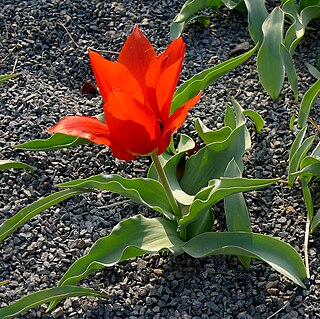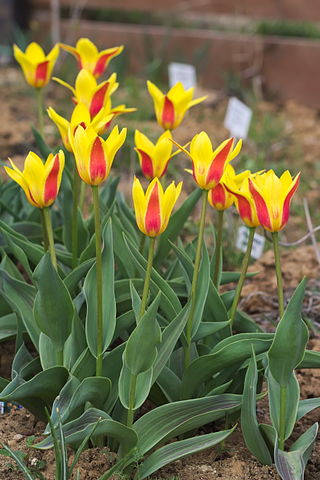
Tulipa turkestanica, the Turkestan tulip, is a species of tulip native to Central Asia. It was first described by Eduard August von Regel in 1873 as a variety of T. sylvestris, then elevated to full species status two years later.

Tulipa gesneriana, the Didier's tulip or garden tulip, is a species of plant in the lily family, cultivated as an ornamental in many countries because of its large, showy flowers. This tall, late-blooming species has a single blooming flower and linear or broadly lanceolate leaves. This is a complex hybridized neo-species, and can also be called Tulipa × gesneriana. Most of the cultivars of tulip are derived from Tulipa gesneriana. It has become naturalised in parts of central and southern Europe and scattered locations in North America.

Tulips are spring-blooming perennial herbaceous bulbiferous geophytes in the Tulipa genus. Their flowers are usually large, showy, and brightly coloured, generally red, orange, pink, yellow, or white. They often have a different coloured blotch at the base of the tepals, internally. Because of a degree of variability within the populations and a long history of cultivation, classification has been complex and controversial. The tulip is a member of the lily family, Liliaceae, along with 14 other genera, where it is most closely related to Amana, Erythronium, and Gagea in the tribe Lilieae.

Crocus chrysanthus, the snow crocus or golden crocus, is a species of flowering plant in the family Iridaceae. It is Native to the Balkans and Turkey, it bears vivid orange-yellow bowl-shaped flowers. It has smaller corms and a smaller flower than the giant Dutch crocus, although it produces more flowers per corm than the latter. Its common name, "snow crocus", derives from its exceptionally early flowering period, blooming about two weeks before the giant crocus, and often emerging through the snow in late winter or early spring. The leaves are narrow with a silver central stripe. Height: 3–4 inches (7.6–10.2 cm).

Tulipa urumiensis, the late tulip or tardy tulip, is a species of flowering plant in the family Liliaceae. It is a perennial growing from a bulb. By some sources the accepted name is Tulipa tarda. It has a leathery tunic that is glabrous on the inside. It has up to seven linear green leaves that can be up to 20 cm long. The stem is between 4 and 20 cm long. The yellow flowers have white tips, anthers and stamen are yellow.

Tulipa armena is a species of flowering plant in the Liliaceae family. It is referred to by the common name Armenian tulip, and is native to the historical Armenian Highlands as the name implies; current regions of Armenia, modern day Turkey, Iran, South Caucasus, and Azerbaijan.

Tulipa sprengeri, or Sprenger's tulip, is a wild tulip from the Pontic coast of Turkey. It is quite rare and possibly extinct in the wild, but widely cultivated as an ornamental.

Tulipa suaveolens, synonym Tulipa schrenkii, the van Thol tulip or Schrenck's tulip, is a bulbous herbaceous perennial of species of tulip (Tulipa) in the family of the Liliaceae. It belongs to the section Tulipa. It is the probable wild ancestor of the garden tulip.

Tulipa linifolia, the flax-leaved tulip or Bokhara tulip, is a species of flowering plant in the tulip genus Tulipa, family Liliaceae, native to Tajikistan, Uzbekistan, northern Iran and Afghanistan. Growing to 20 cm (8 in) tall, it is a bulbous perennial with wavy red-margined sword-shaped leaves, and bowl-shaped red flowers in early to mid-spring. Each petal has blackish marks at the base.

Tulipa eichleri, commonly known as Eichler tulip or Eichler's tulip, is a species of tulip. It is a bulbous flowering perennial with long green leaves,deep red flowers with a central black blotch, coming from the Caucasus Mountains.

Tulipa hungarica, the Danube tulip, Banat tulip or Rhodope tulip, is a species of flowering plant in the family Liliaceae. It is also in the subgenus Tulipa. It is found on the rocky mountainsides of Bulgaria, Romania, Hungary and Slovenia, especially along the gorges of the river Danube. It has small bright yellow flowers in spring and blue-grey leaves.

Tulipa alberti, or Albert's tulip, is a species of flowering plant in the family Liliaceae. It has long reddish, orange or pink flowers. It comes from the mountains of Central Asia.

Tulipa orphanidea is a species of flowering plant in the Liliaceae family. It was described by Pierre Edmond Boissier and Theodor Heinrich Hermann von Heldreich (1862).

Tulipa montana is a species of tulip native to the mountains of Iran and Turkmenistan. With its deep red petals it has been proposed as a candidate for the Biblical Rose of Sharon, whose identity is unknown.

Tulipa biflora, the two-flowered tulip, is a species of tulip, native to the former Yugoslavia, Crimea, Anatolia, the Caucasus, southern Russia, Egypt, the Middle East, Central Asia, Iran, Pakistan, Afghanistan and Xinjiang in China. It has many synonyms, including Tulipa polychroma.

Tulipa fosteriana is a species of tulip, native to the Pamir Mountains and nearby areas of Afghanistan, Kyrgyzstan, Tajikistan and Uzbekistan.

Tulipa kaufmanniana, the water lily tulip, is a species of tulip native to Central Asia.

Tulipa greigii, is a species of tulip native to Central Asia and Iran.

Tulipa ingens, the huge tulip, is a species of flowering plant in the family Liliaceae, native to Uzbekistan and Tajikistan. A bulbous geophyte reaching 40 cm (16 in), it is found growing in only 45 to 55 stations at elevations from 1,200 to 2,500 m. The Royal Horticultural Society lists it as a dwarf tulip, stating that it blooms in early spring with black-centered scarlet red flowers.



















